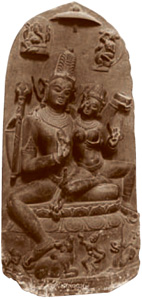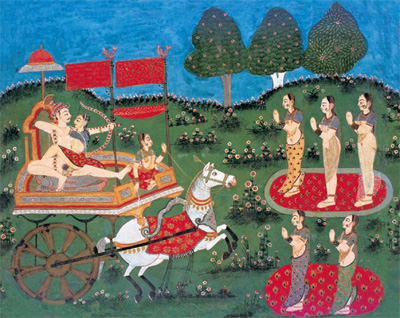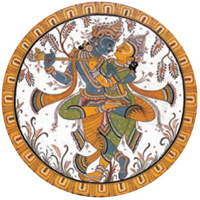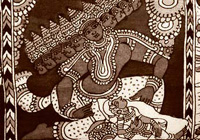Dharma, artha, kama

Trivargapratipatti Prakarana

 an, the period of whose life is taken to be one hundred years, is advised to practice
dharma, artha and kama at different times and in such a manner that they harmonize together. In his childhood he should acquire learning; in his youth and middle age he should attend to
artha and kama, and in his old age he should perform dharma, and seek
moksha, or release from further transmigration. Or, on account of the uncertainty of life, he may practice them together at times. But it is essential that he should lead the life of a religious student until he finishes his education.
an, the period of whose life is taken to be one hundred years, is advised to practice
dharma, artha and kama at different times and in such a manner that they harmonize together. In his childhood he should acquire learning; in his youth and middle age he should attend to
artha and kama, and in his old age he should perform dharma, and seek
moksha, or release from further transmigration. Or, on account of the uncertainty of life, he may practice them together at times. But it is essential that he should lead the life of a religious student until he finishes his education.

Parvati is the goddess of beauty and exceedingly voluptuous to behold. Her mere presence was sufficient to arouse the uncontrollable desires of Shiva.
Dharma is obedience to the command of the Shastras, the Holy Writ of the Hindus, to commit certain acts. These include the performance of sacrifices, which are not generally carried out because they are offerings to the gods and often produce no visible effect. The Shastras forbid certain practices such as eating meat, which are often followed because they are part of material life, with very visible effects.

Kama makes passionate love to his consort Rati, who signifies lust and sexual delight. Apsaras, or heavenly damsels, the handmaidens of Kama, personify celestial beauty and stand with their hands folded in reverence of this heavenly union.
Dharma should be learned from the Shruti and Vedas, and from those conversant with it.

Radha and Krishna in union.
Artha implies the acquisition of art, land, gold, cattle, wealth and friends; the protection of what is acquired; and the increase of what is protected. It should be learned from the king's officers, and from merchants who are versed in the practices of commerce. Kama is the enjoyment of objects by the five senses of hearing, touch, sight, taste and smell, assisted by the mind and the soul. The peculiar contact between the organ of sense and an object, and the consciousness of pleasure which arises from that contact is called kama.
Kama is to be learned from the Kama Sutra - Aphorisms on Love, and from the experience of citizens.
When all the three, dharma, artha and kama come together, the former is better than the one which follows it. Dharma is better than artha, and artha is better than kama. But artha should always first be practiced by the king for the livelihood of men is to be obtained from it only. Again, kama being the occupation of veshyas, or prostitutes, should be preferred by them to the other two. However there are exceptions to the general rule.
Some learned men opine that both dharma and artha can be learnt only from books. But kama which is to be found everywhere and practiced even by brute creation does not require any study on the subject.
This is not so. Sexual intercourse being dependent on man and woman requires the application of proper means by them, and these are to be learned from the Kama Shastra. The non-application of proper means which is seen in brute creation is caused by their unrestrained behavior, and sexual intercourse with females during certain seasons only - this intercourse not being preceded by any thought.
The Lokayatikas say: Religious ordinances should not be observed for they promise a future fruit, and it is doubtful whether they will bear any fruit at all.
This is not so. The Holy Writ which ordains the practice of dharma, does not admit of a doubt.

Ravana abducting Rama's wife Sita in a clear violation of dharma, for which he had to pay with his life.
Sacrifices such as those made for the destruction of enemies or for the fall of rain are seen to bear fruit. The sun, moon, stars, planets and other heavenly bodies appear to work intentionally for the good of the world. The existence of this world is affected by the observance of the rules respecting the four classes of men and their four stages of life. Vatsyayana is therefore of the opinion that the ordinances of religion must be obeyed.

Everything is in the hands of destiny, which controls gain and loss, success and defeat, pleasure and pain. Thus we see that Bali was raised to the throne of Indra by destiny, and was also put down by the same power, and it is only destiny that can reinstate him.
It is not right to presume that everything is determined by destiny. The acquisition of every object presupposes some exertion on the part of man. It, therefore, follows that even where something is destined to happen, a person who puts in no individual effort will not enjoy happiness.
Those who are inclined to think that artha is the chief object to be obtained state: Pleasures bring a man distress, and into contact with low persons; they cause him to commit unrighteous deeds, make him impure and uncaring about the future, and encourage carelessness and levity. They cause him to be disbelieved by all, received by none, and despised by everybody, including himself.
This argument cannot be sustained, for pleasures are as necessary for the existence and well-being of the body as food. Moreover they are the results of dharma and artha. They should, however, be followed with moderation and caution.
There are some shlokas, verses:
Thus a man practicing dharma, artha and kama enjoys happiness both in this world and the world to come. The good perform actions without fear of the result from them in the next world, and without danger to their welfare. Any action which is conducive to the practice of dharma, artha and kama together, or of any two, or even one of them, should be performed, but an action which encourages the practice of one of them at the expense of the remaining two should not be performed.